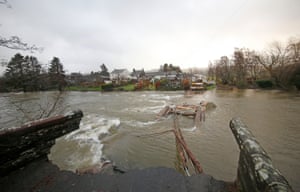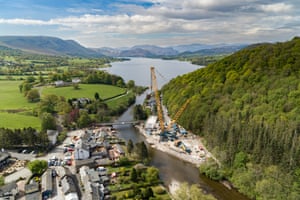When Pooley Bridge lost its namesake crossing to the torrential floods of Storm Desmond in 2015, the picturesque Lake District village was robbed of more than just a route over the water. “It was like losing a well-loved relative,” says Miles MacInnes, chairman of the parish council. “Our community was split in two.” It was the symbol of the place, the essence of the community’s identity. As one local resident said: “We’ll have to call ourselves Pooley No Bridge now!”
At Granny Dowbekin’s Tearooms, which had overlooked the historic bridge for generations, there was another dilemma. What would become of their trademark hand-baked delicacy, the Pooley Gingerbridge biscuit? “We’ll have to sell it in bits,” said baker Sarah Fowler.

The handsome, three-arched stone bridge had stood in the Ullswater valley since 1764. It was originally built to replace a set of ancient stepping stones across the River Eamont, providing an important connection between the historic counties of Cumberland and Westmorland. Overnight, as storm waters eroded the riverbed around the base of the bridge supports, more than 250 years of history were swept away.
“It felt somewhere between a bereavement and a disaster movie unfolding in front of us,” says the tearoom owner, Colin Hindle, who looked on as the mortar pinged from the joints and the stone blocks tumbled into the cascading torrent. “They built the best bridge they could in the 1700s. We owe it to the future to build the best bridge we can now – and I think they’ve done exactly that.”

Five years on, a remarkably lean new bridge now spans the Eamont, right outside the tearoom terrace, which looks out on an autumnal scene of golden leaves covering the wooded hill of Dunmallet, and the broad expanse of Ullswater twinkling in the distance. Fresh honey-coloured sandstone abutments stand on each bank, with the bridge leaping across the space between in a single bound. Like its predecessor, this taut arc of concrete and steel is as unfussy as it is robust, a pragmatic way to carry Land Rovers, tourists and herds of sheep alike – as well as withstand future floods. Yet it also hovers above the current with a gossamer elegance, its railings shimmering like a layer of Lakeland mist hanging over the water. It is a refreshing change from the clunky temporary truss bridge, more familiar to war zones, that the village has lived with for the last few years.
The design is the work of Knight Architects, a firm of bridge specialists based in High Wycombe, Buckinghamshire, who have built over 40 spans around the world, from a tilting road bridge in New Zealand to a tram and cycle bridge over railway tracks in Germany, as well as footbridges around London’s Olympic park. While new bridges are often conceived as effusive signatures, in the costly Santiago Calatrava mould, Knight are experts in blending into the background, advocates of “the beautiful ordinary” as they call it.
“The challenge here,” says Hector Beade Pereda, the Spanish engineer at Knight responsible for the project, “was to be modern, but not too modern. Some people wanted to see the original rebuilt exactly as it was, while others were keen for something really innovative that could be a tourist attraction in itself.” Unusually for an infrastructure project, there were a large number of public consultation sessions, which most of the village’s 100-strong population attended, all with strong opinions. The tearoom also ran a competition for children to submit their ideas, the winning entry a fantastical rainbow-coloured snake, its forked tongue forming a ramp for cars to make a daring leap to the other side.
In the end, it was historic Swiss and Scottish engineers, rather than serpents, who inspired the final design. The daring spans of Robert Maillart’s 1930s gymnastic bridges across the Alps were a key reference, but the primary model was Thomas Telford’s 1814 Craigellachie Bridge in Moray, Scotland, itself an elegant steel arch springing from two stone abutments.

The new GBP5m Pooley Bridge looks as if Telford’s iron span had been stripped down to its leanest possible form. It is an incredibly slender thing for a road bridge, made possible by the use of ultra-strong duplex stainless steel in combination with a cast in-situ concrete arch and deck. Prefabricated off-site in Darwen, Lancashire, in four chunks, the 40-metre, 100-tonne span was assembled in the riverside car park, where the concrete arch was then poured, and the whole thing dramatically lifted into place in one piece using the biggest crawler crane in the UK – a product of necessity given the constraints.
“We only had a very small window to be working over the river,” says Craig Mitchell, project manager for the bridge at Cumbria county council, who has led the area’s GBP124m infrastructure recovery programme, overseeing repairs to more than 450 bridges damaged by the storm. “We couldn’t interfere with the tourist season, which runs from May to October, and we couldn’t disturb the salmon spawning season, which runs from October to May.” Finding a tiny window between crowds of people and fish spawn, the bridge was lifted in January this year and finally opened to the public in October , with some detailing still to be finished.
Walking across the new structure, your feet move from tarmac to buff sandstone pavers, with the names of crowdfund donors etched into some of the slabs. The pavement widens subtly towards the centre, as does the broad wooden handrail, providing more space to have a lean and take in the view – and, crucially, to play Poohsticks (a recurring request in the consultation).

From a distance, the wafer-thin railings seem to dissolve into thin air. They seem impossibly slight for a road bridge, which usually come with bulky barriers designed to withstand vehicle impact. But here the architects have cleverly incorporated the barrier in the form of a raised granite kerb, allowing the sides of the bridge to be as open as possible. Similar optical trickery has been deployed down below, where the v-shaped spandrels of the arch give the impression of even thinner toothpick-like struts, while the edges of the main beams are also set at an angle, visually reducing their bulk. Meanwhile, all finishes have been left raw and exposed, eliminating the need for repainting in future.
If it all seems simple and straightforward, that’s deceptive. Typically, a clear span bridge like this would have deep pile foundations on either bank. But here, even after drilling 15 metres into the ground, the engineers didn’t find rock. So instead, hidden steel “backspans” secure the load, using two metre-long bolts. It is the principle of a tied arch bridge, where the arch is above the deck, but cleverly rejigged to give the structure as slim a profile as possible – and not obstruct the view.
There’s only one downside to the new-look Pooley Bridge being so slender. “It’s so sleek and elegant,” says Hindle. “It doesn’t really make for a good biscuit.”